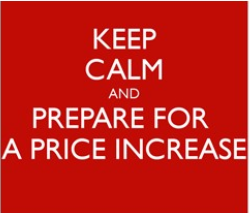

Price increases are a fact of life. As much as consumers and industrial buyers may resist, most are understanding provided the change is properly communicated. To avoid alienating customers, sound change management practices can avoid alienating customers. Change Management 101 states that change be communicated in a timely manner to internal and external stakeholders, including customers. This blogger recently received a quarterly statement from a service provider (who shall remain nameless) that announced a price increase effective immediately. Based on my experience, the provider’s customer service center was besieged with calls regarding the change as agents offered a well-rehearsed, empathetic response, but no satisfaction. In the opinion of this blogger and consumer, the provider managed the change as poorly as the service it provides.

Advising the customer, industrial or consumer, of an immediate price increase in an invoice is not recommended. Blaming the customer for the increase could create alienation especially if the relationship is already tenuous. This blogger took it personally when reading this message on the invoice from the local trash hauler (Note: Identifiers have been removed):
“Due to the growing amount of contaminated materials placed in recycling containers, we are instituting a new recycling processing charge. See the enclosed insert and our website for details.”
Based on my history with this provider and without further explanation my reaction was, quite frankly, outrage. Customer service attempted to explain it, but unsatisfactorily. Finding an announcement of the website was a challenge too, but buried in the FAQ section is this explanation:
The Recycling Processing Charge is necessary due to the overwhelming amount of contaminated recyclables that are threatening local recycling programs. To ensure the viability of local recycling programs, we must find alternative solutions for the contaminated materials, and it substantially increases costs for local recycling programs.”
Unsatisfied with the explanations given, I proceeded with my own investigation and it was eye opening. Who knew the world is experiencing a recycling crisis? A Google News search of the term “recycling crisis” returns 246,000 results. The crisis is a topic of a future blog, but suffice to say, it has my attention. While single stream recycling, mixing paper and containers, makes the activity more palatable for the public, it also creates greater opportunities for misuse and therein lies the rub. Regardless of the circumstance, this provider still gets a failing grade in change management.
Hindsight is 20/20, but a different approach would have made a world of difference. My recommendation would have been a staged approach. For example, in the first quarter conduct an educational campaign. This is the appropriate time to distribute an informational piece stressing the desired behavior change. In the second quarter invoice, a statement to the effect that progress has been made, but a price increase effective in the next quarter would be necessary to sustain the change. Advising the customer in advance of price increase and how much it will be allows time for it to be accepted. Actual implementation of the increase would occur in the third quarter invoice. Customers may still resist the increase, but will at least better understand it.

